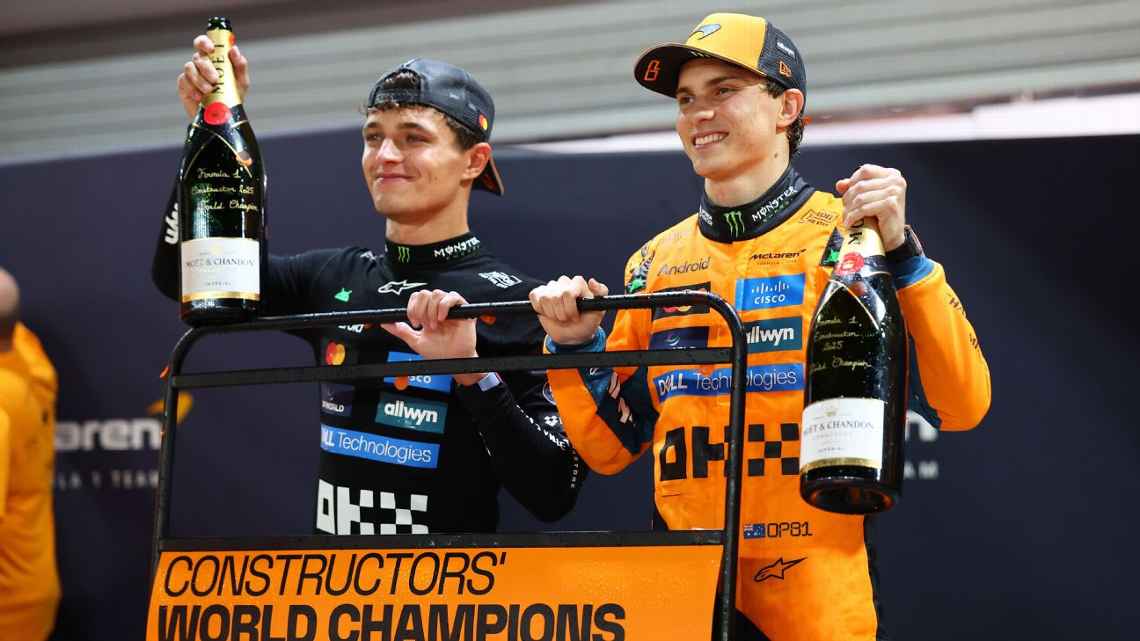The dust may have settled on the Singapore Grand Prix, but the ripple effects of the opening lap clash between McLaren teammates Lando Norris and Oscar Piastri continue to reverberate. What initially seemed like a minor racing incident has quickly escalated into a fascinating study of team dynamics, championship aspirations, and the precarious balance a Formula 1 team must maintain when its two brightest stars are also its fiercest rivals.
Singapore`s Fiery Start: A Collision of Ambition
The streets of Singapore are notoriously unforgiving, a concrete labyrinth where millimeters dictate fortunes. It was here, amidst the dazzling night lights, that the burgeoning rivalry within the McLaren camp truly ignited. From the fifth grid slot, Norris launched his McLaren with characteristic aggression, aiming to capitalize on any early opportunities. His path brought him alongside teammate Piastri as they navigated the tight Turn 1 and Turn 2 sequence.
As the pair approached Turn 3, with Max Verstappen ahead, the margin for error evaporated. Norris, seeking to gain position, clipped Verstappen`s Red Bull, causing his car to momentarily lose traction and slide sideways. In a cruel twist of fate, this led to an unavoidable second collision – this time with Piastri, who was attempting to thread his own line around the outside. The contact resulted in Norris securing third place, ultimately leading to a podium finish ahead of his teammate, who crossed the line in fourth.
“I mean … that wasn`t very team like, but sure,” Piastri`s terse radio message echoed, a stark indication of immediate frustration. His subsequent exchange with race engineer Tom Stallard further underlined his perspective: “If he has to avoid another car by crashing into his teammate, that`s a pretty s— job of avoiding.”
From Piastri`s vantage point, with the contact with Verstappen obscured, it appeared Norris had simply veered into him. It was an incident that challenged McLaren`s well-established “papaya rules” – an unofficial but firm directive that permits drivers to race each other hard, but explicitly without collision. Given previous near-misses and team interventions (like the one in Italy where Piastri was asked to return a position), the lack of immediate action from the pit wall in Singapore raised eyebrows.
The Team`s Verdict: A Racing Incident, or a Precedent?
McLaren team principal Andrea Stella was quick to categorize the event as a direct consequence of Norris`s initial contact with Verstappen, therefore deeming it a “racing incident” and not warranting a team-mandated position swap. Stella acknowledged Piastri`s frustration as understandable, even encouraged, believing open communication preferable to simmering resentment.
Yet, the nuance of the situation is not lost on anyone following the sport. While the FIA stewards also took no further action, the internal ramifications for McLaren are far more significant. The “papaya rules” are a delicate framework, designed to balance individual ambition with team cohesion. But in the heat of a championship battle, when every point counts, interpreting these rules becomes a high-wire act.
The Championship Tightens: More Than Just Points
With six races remaining, the stakes couldn`t be higher. Piastri currently holds a 22-point advantage over Norris, while Verstappen, despite not being directly involved in the McLaren internal drama, is a mere 63 points behind Piastri, steadily closing the gap. This converging points situation is the true crucible for McLaren`s management philosophy.
As the season progresses, the pressure on both drivers will intensify, and with it, the likelihood of similar 50/50 situations. Each driver, driven by a primal competitive instinct, will naturally interpret the rules in a way that benefits their own championship aspirations. This inherent conflict is the “papaya paradox” – the very success that brings them closer to a title also pushes them closer to a potential breaking point.

Lando Norris (left) and Oscar Piastri (right) under the spotlight as their F1 season rivalry intensifies.
The Road Ahead: A Test of Leadership
Andrea Stella`s commitment to the “let them race” principle is commendable, fostering an environment where competitive fire is encouraged. However, as he himself admits, “this is hard.” Managing two ambitious talents who, by definition, cannot have entirely aligned interests, requires constant communication, transparency, and, crucially, consistent application of team policy.
The challenge for McLaren isn`t merely to prevent future collisions, but to maintain a united front and a shared sense of purpose in pursuit of the Constructors` title, even as individual drivers vie for supremacy. It`s a testament to the character of both Norris and Piastri that they`ve navigated such pressures successfully so far. Yet, the final stretch of the season will be the ultimate test of their professionalism and the team`s ability to maintain control without stifling the very drive that makes them champions.
Ultimately, in the high-stakes world of Formula 1, where split-second decisions and raw ambition define careers, rules are often more of a guideline. McLaren finds itself navigating a fascinating, and potentially volatile, course. The success of their season, and perhaps the future dynamic of their formidable driver pairing, hinges on how deftly they walk this tightrope.
